By the 1920s, Coney Island was extremely crowded in the summer. Perhaps 1,000,000 people would come to the island on a busy Saturday. The beach would be so crowded one could barely find a place to sit. Couples would be surprisingly affectionate, on the beach and elsewhere. In fact, many people thought the whole environment was rather dirty.
The rich were more likely to go somewhere exotic by automobile than go to such a popular place, where class differences were minimized, and which many immigrants (and people of all races) fancied.
But some people who hated Coney Island in the daytime admitted it had a charm after dark. The bright lights of all the attractions were enchanting, even to some who disliked the island's daytime image. Late at night, clubs might have bands or even dancing. Sometimes musicians played outside, too. Day and night, crowds would talk, and barkers would stand outside shows, trying to draw audiences in. It was a loud place.
The rich were more likely to go somewhere exotic by automobile than go to such a popular place, where class differences were minimized, and which many immigrants (and people of all races) fancied.
But some people who hated Coney Island in the daytime admitted it had a charm after dark. The bright lights of all the attractions were enchanting, even to some who disliked the island's daytime image. Late at night, clubs might have bands or even dancing. Sometimes musicians played outside, too. Day and night, crowds would talk, and barkers would stand outside shows, trying to draw audiences in. It was a loud place.


What did Lovecraft think? He was brutal in his comments about Pelham Bay Park (1) so one assumes the same applied to Coney Island.
On or about 22 July 1925 HPL (2) visited Coney Island at evening. He indicates this is his second trip (the previous was 3 weeks prior). He entered with his party into Luna Park and saw the open air circus and wandered over to the "Room of Wonder".


It galled him that it stated that it was "advertised to upset all known principles of gravitation." He found the optical illusions clever, but "I understood it at once". "A series of eccentric passageways with walls futuristically painted & floor inclined in many different ways so that one had the effect of treading tortuous rising & falling & tilting avenues in some analogue of the Mammoth Cave ... one felt at once that something must be radically wrond with the force fo gravity; for though the floor was fairly level. one was impelled irresistably forward & downward in certain direction - so that hand rails were needed to steady the traveller."
He describes other disorienting illusions ( a bowling ball that goes uphill) and sketches them to Aunt Lillian.
"We left by passages as circuitous & cleverly confusing ... noting as we so the amazed conjectures of other voyagers."
That's not all, so proud he deciphered the illusion, he shows Sonia who beams prroudly and tells the game keeper that HPL has deciphered the riddle. The gateman studies the quick sketches and is amazed that HPL has deduced the mystery - "that dignitary professed a respectful surprise upon seeing my pencil diagram ... admitted I was right, inquired what my profession was, & stated that he had seldom seen soultions produced so completely on the spot."
Old reminisceses of Luna Park have recalled Lovecraft's locale "a large fun house", "The Pit" or "Luna Funhouse". One site mentions Lovecraft's experience as being built about 1923. It claims that management didn't have a clue what the public wanted or what might be successful so they changed things often. For the fun house they built a walk in, walk around crazy house called "Thru the Falls" and a high slide dubbed the "Down & Out Slide". A figure eight slide called the "Soft Spot" was just for kids. About 1923 the management poured $100,000 to revamp the fun house into "The Pit" and billed it "A kaleidoscope of Fun."

1. p. 148, Letters from New York, ed. Joshi, Lovecraft is at his racist worst here. Since this is a public blog, I will not repeat verbatim the denigrating and derogatory racial epithets Lovecraft used, but he states, "My Pete in Pegana, but what crowds. And that is not the worst ... for upon my solemn oath ... full nine of ten were {black}. Help! ... wilted by the sight we {took} a side path {to} the subway."
2. Ibid. pp. 150-153.
No comments:
Post a Comment